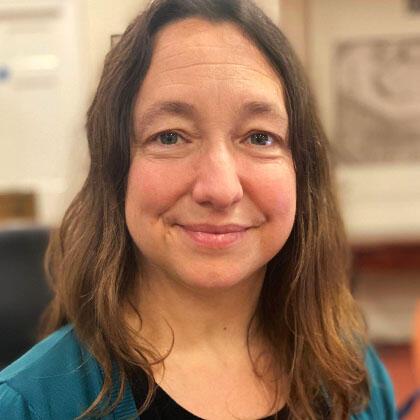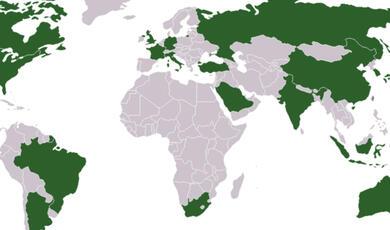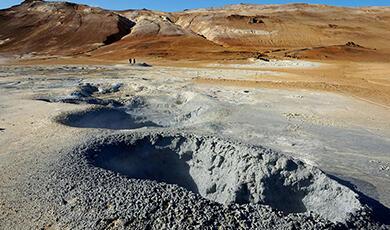Exploring the Deep Sea
Share
- Details
- Text
- Audio
- Downloads
- Extra Reading
The Deep Sea is Earth’s last great frontier. After almost 150 years of exploration and research we understand it is deep, dark and definitely different; but there remain large gaps in our knowledge that hinder progress in sustainable management of this vast system. New technology – from manned submersibles, to satellite measurements, acoustic systems, and artificial intelligence – is key to future research, and the next ten years promises to deliver a new age of deep-sea science.
Image © NTNU Vitenskapsmuseet CC-BY 2.0
Download Text
Exploring the Deep Sea
Professor Kerry Howell
15th February 2022
Welcome to the deep-sea. I’d like to give you an introduction to what is most of our planet and then explain how our understanding of this vast biome has been and continues to be shaped by the tools we use to explore it.
The Deep-Sea Environment and Early Exploration
The ocean covers about three quarters of the Earth's surface and has an average depth of around 3000m. If you rotate the earth to give you a view of the Pacific you can see that we really are planet Ocean, as opposed to planet Earth. The majority of our ocean, around 90%, is what we call deep sea. The deep sea is traditionally described as the marine area off the continental shelf. In Europe the continental shelf tends to break at about 200m deep, where the terrain then slopes more steeply down toward the abyssal plain, great relatively flat expanses of seafloor around 4-5km deep. The history of exploration of the deep sea really began 150 years ago with Challenger. Many of you will automatically think of the space shuttle Challenger. However, the space shuttle was named after the original Challenger, a British naval vessel.
Challenger set sail from Portsmouth in 1872 and spent four years exploring the World’s Ocean. It circumnavigated the globe taking 492 depth soundings to try to understand the shape of the sea floor and taking the temperature of the ocean. It visited 362 stations, 133 using dredges, to search for evidence of life in what was widely believed to be a completely inhospitable place thanks to Forbes Azoic Theory. Forbes had conducted sampling in the deep part of the Aegean Sea and found no life. Little did he know the Aegean is unusual. So, despite much evidence to the contrary Forbes’ theory persisted for just over two decades before Challenger put the final nail in the coffin. Over 4000 new species were described as part of 50 volumes that were the final output of this endeavour. The primary purpose of the Challenger Expedition was to provide information on the terrain of the seafloor in support of laying of new electric telegraph cables. The soundings made helped them develop this map of this seabed, which reveals the discovery of the Mid Atlantic Ridge, and many of the deep ocean trenches, including the Mariana Trench, in which the deepest part is named after Challenger, ‘the Challenger deep’.
The equipment they used to search for life in the deep ocean you may think was pretty basic.
In fact, for much of the 150 years since Challenger, dredges and trawls have been a mainstay for deep-sea biological science. Fig. 1 shows a recent photo of a dredge being deployed from a modern research vessel operating in Antarctica and an image from the Challenger Expedition where the dredge is clearly visible in the background. Dredges and trawls are very useful. They can provide us with physical specimens of animals that we can study and preserve, to gain some understanding of their biology. They can also tell us about what animals are found where in a very general sense.
This type of sampling, as well as depth soundings, and use of thermometers and other physical sampling tools, has taught us a lot about the deep sea. We know that pressure increases by one atmosphere every 10 meters. We know that light decreases with depth, such that, at around 200 meters, there is generally not enough light for photosynthesis anymore e.g. no plant or algal life. By about 1000 meters, there's no sunlight at all. We enter a world that is completely dark, save for that very beautiful light created by animals, called bioluminescence. We know that temperature decreases with depth. Surface waters maybe 10-15 degrees C or so around the UK, and warmer around the tropics, but as you go down through the water column, the temperature decreases. By about 1000 meters, it's only about four degrees C. That's the same temperature as your fridge. By the time you get down onto the abyssal plain at 4-5km deep, the temperature is around one degree C. So, the deep-sea environment is dark, it's cold, and the pressure is immense, much more than a human can stand.
The water column itself is the largest habitat on earth by volume. However, it isn't just one big mixed mass of water. There is structure in the water column. We can detect different bodies of water, different water masses that have different temperature and salinity signatures. They sit one on top of the other, with clear boundaries between them in the form of density surfaces.
As photosynthesis is not generally possible below 200m, all plant and algal life tends to live above this depth. However, plant and algal life forms the basis of the food web, so most deep-sea animals rely ultimately on a food source that only grows in the top of the ocean. Below this depth animals have to rely on food sinking down from the surface in the form of marine snow, or prey actively migrating deeper after feeding in this shallow water. Both mechanisms bring food into the deep sea, but food is scarce, and the deep-sea is often considered food limited. Only around 1 to 3% of surface primary production reaches the abyssal plain.
We have also learned that animal life changes as you move from the shelf to the abyss. Le Danois (1948) spent a good part of his career trawling the seabed of the European continental slope and documenting the animal life he bought to the surface. He produced beautiful maps that depict the change in animal life with depth. The animals that live in the shadow parts of the ocean are quite different to those that live in the deeper parts. Animal life continually changes with depth, but we have areas of lesser formal change bounded by areas of greater formal change, presenting as different animal zones as you go down from the shelf into the deep sea
Limitations Brought by the Tools Employed
Our view of the deep sea has been shaped by the tools we have used to explore it. Trawls and dredges, while useful, have some serious limitations one of which is best illustrated by an analogy drawn by a well-known benthic biologist Peterson. In his landmark paper of 1913, he likened dredging the seabed to towing a bucket from a hot air balloon and basing your understanding of your capital city on what you retain in the bucket. So imagine for a moment you have an impossibly large bucket that you're towing from your hot air balloon flying over London, you drag it on the ground for a kilometre or two, and then you bring it back up to your balloon, look inside, and base your understanding of London on what's in your bucket. I hope you can see that that would give a very limited view of city life. You will have lost any kind of contextual information, for example the red buses were on the road, the tourists were on the pavement. In addition, trawling and dredging is largely limited to soft sediment habitats. If you try to trawl on rocky ground, you completely destroy your net. As a result, much of our knowledge of the deep sea is focused on soft sediment habitats, we know less about the biology of rocky terrain. The technology employed in study restricted our view of the deep sea. However, the rapid development of camera technology that has taken place over the last 30-40 years has changed the face of deep-sea science; allowing us to observe this environment in-situ.
The Age of Visual Survey
An early example of use of in-situ visual observations is in the use of manned submersibles. I'd like to share with you some early footage from the Pisces III submersible from Rockall Bank, an important submarine feature west of Scotland. This beautiful black and white footage is from a deployment that took place in 1973 where biologist John Wilson was making observations of a cold-water coral reef thicket. I’d like you to pay particular attention to what John Wilson is saying.
https://youtu.be/bxVA1M-rnDY
Wilson describes a cold-water coral reef thicket. He describes the living coral as growing on the edges of the reef. He also mentions how they are growing in relation to the prevailing current. He notes which polyps are feeding and how they are feeding, noting that they pluck little crustaceans (copepods) from the water column, and that there are a lot of copepods. The ability to simply observe these animals in-situ has immediately provided an enormous amount of information that it is not possible to gain from a trawl. What John Wilson looking at was a cold-water coral reef thicket (Fig 2). You can see from Fig 2 some of the features Wilson mentioned, for example where the live coral growths are, including their growth on only one side of the thicket. You can also see the Sabellid worms he mentions, and you can see the importance of the area to fish species.
In 1977 use of manned submersibles was central to the discovery of life at hydrothermal vents. These incredible structures on the sea floor are formed by the precipitation of minerals from superheated fluids that erupt out of the sea floor as plumes. Essentially seawater that has seeped through cracks in the Earth's crust becomes superheated and dissolves surrounding minerals into the hot seawater, which is then forced back out through the Earth's crust. On contact with cold sea water, the minerals precipitate out forming a chimney-like structure, which we recognise as a hydrothermal vent. Follow the link to see footage from some of the deepest vents known.
https://youtu.be/y6iK19xaYJg
In the footage you can see some of the unique life found at hydrothermal vents, the scaly footed snail, vent shrimp, and yeti crabs. Hydrothermal vents are a unique ecosystem that is based on chemosynthetic primary production rather than photosynthetic production. That is plants and algae do not form the basis of their food-webs. Their food-webs are based on bacteria and archaea that use chemical compounds in the venting hot seawater, usually sulphur or methane, as a form of chemical energy they use to grow their biomass. Animals feed on the mats the bacteria form. Some organisms have formed symbiotic relationships with these bacteria and are able to obtain their nutrition directly via that bacterial pathway. These are very different ecosystems to those that had previously been described in deep sea, and their discovery was only really possible through the use of in-situ observations and use of camera technology.
Camera technology has now come of age and coupled with developments in robotic technology, is now enabling us to explore the deep sea in new and previously unimaginable ways. Fig. 3 shows an example of a large robotic vehicle, or remotely operated vehicle (ROV) being deployed from large research vessel. The accompanying image shows the view inside the vehicle control room. There are three pilots who sit at the front of the control room, drive the vehicle and operate the arms. Behind there is another set of screens where three scientists sit instructing the pilots on science operations and documenting observations. ROVs allow us to observe important and sensitive habitats like cold water coral reef, which themselves form habitat for other species like crabs and fish. Their manipulative abilities enable us to carefully collect samples from which we can learn more about the animals. However, collection of samples is time consuming and takes all three pilots. One on each arm and one driving the vehicle. It is technically very challenging, and the pilots are highly skilled. Better manipulative capability also facilitates the possibility of in-situ experimentation and precise observation and measurement, for example holding a thermometer directly into a vent plume to get an accurate reading.
Mapping the Seafloor
We have learned much since camera technology and robotics opened up the scope of what it is possible to study in the deep sea. So do we really know more about the moon than the deep sea? The answer is obviously no, we know quite a bit about the deep sea, but there is one area for which the statement is true, and that is in relation to terrain mapping. We have mapped the surface of the moon at a resolution of 100 x 100 meters. Similarly, we have mapped the surface of Mars at that resolution. However, we have only mapped ~20% of the ocean floor at a resolution of < 1km. You may be thinking that you have seen a detailed map of the seafloor, for example in Google Earth, and you would be correct. We do have a map of the seafloor, but the resolution is poor at only ~5x5 km. That map is developed using satellite altimetry data. Satellites use radar to detect small distortions of the ocean surface made by the presence of large features on the seafloor. By measuring these distortions, we can use them to infer the shape of the underling seabed. These measurements are combined with finer scale data from depth soundings and echo-sounders to give a merged final map of the seabed. However, we know these maps are inaccurate and especially in the poorly sampled parts of the world ocean like the South Atlantic and Indian Ocean.
Development of higher resolution seafloor maps requires the use of multibeam echo sounders. These devises use sound to ‘see’ the seabed, rather like bats use sound to see. They are echo sounders consisting of multiple beams (hence the name multibeam) that can provide a wide swath of information on seabed terrain. So far less than 20% of the global seabed has been mapped using multibeam. There is, however, a new global programme aiming to map the seafloor by 2030. Seabed 2030 is a seafloor mapping programme endorsed by the International Oceanographic Commission as a programme under the Decade of Ocean Science for Sustainable Development. While it represents an important step in further developing our understanding of the deep sea is does only focus on seafloor terrain and not the animals that live there. In terms of biological samples much less than 0.001% of the deep sea has been sampled, meaning there is still a lot to do in terms of exploring this biome. The truly vast size of the system and expense of working there remains a major barrier to furthering knowledge, but one we must overcome. In recognition of the original expedition, Challenger 150 is a new biologically focused Ocean Decade programme that aims to address this knowledge gap.
The Age of Autonomous Systems
In overcoming the challenges in biological study, we are likely to shift to increasing use of autonomous platforms. These platforms are capable of carrying out pre-planned missions unsupported and can remain deployed for extended time periods. There are some limitations of these new methods, the principle one at present is that it is not possible to obtain physical animal specimens via autonomous approaches. In addition, autonomous platforms are often not designed with biological research in mind and therefore platforms designs are sub-optimal. However, these platforms are capable of collecting very large datasets and may help to speed up the rate of data collection in the deep sea. A single deployment may generate terabytes of seafloor image data which then has to be manually analysed by a human observer. Animals in images need to be identified and counted to extract semantic data from raw imagery. It is labour-intensive, skilled but repetitive work. Observers tire rapidly and make inconsistent errors. To realise the potential of autonomous platforms we must find ways to process the big datasets created in an efficient and accurate way. One possible solution is the application of artificial intelligence and computer vision to image analysis. We already use these types of techniques in applications like self-driving cars and facial recognition so it is not such a great leap to consider applying them to marine species identification and enumeration. Early studies suggest that for some species it may be possible to obtain good results, whereas other species are more problematic. Over the next 10 years, we are likely to see autonomous platforms coupled with real time AI analysis of imagery and the dawning of a new age of ocean exploration, one more akin to space exploration. We may yet see deep-sea science have its own equivalent of the Mars Rover, and ironically this development may even be inspired by space rather than ocean exploration. Saturn’s moon Enceladus has an ice-covered surface concealing an ocean in which hydrothermal vents are suspected to present. Interest in exploring this ocean for signs of alien life mean there is now even greater impetus to operationalise autonomous ocean exploration. The Decade of Ocean Science for Sustainable Development looks set to be a very interesting time.
© Professor Howell 2022
References and Further Reading
Woods Hole Oceanographic Institution. https://divediscover.whoi.edu/history-of-oceanography/the-challenger-expedition/
Challenger Society for Marine Science. https://www.challenger-society.org.uk/History_of_the_Challenger_Expedition
National Oceanic and Atmospheric Administration Ocean Explorer. https://oceanexplorer.noaa.gov/explorations/03mountains/background/challenger/challenger.html
Scales, H., 2021. The Brilliant Abyss: Exploring the Majestic Hidden Life of the Deep Ocean, and the Looming Threat That Imperils It. Grove Atlantic. https://helenscales.com/portfolio/the-sea-beneath-us/
Cordes, E., Arnaud-Haond, S., Bergstad, O.A., da Costa Falcão, A.P., Freiwald, A., Roberts, J.M. and Bernal, P., 2016. Cold water corals. The First Global Integrated Marine Assessment, World Ocean Assessment I, United Nations, Cambridge University Press, Cambridge, UK. https://www.un.org/depts/los/global_reporting/WOA_RPROC/Chapter_42.pdf
The Natural History Museum, London. Hydrothermal vents: survival at the ocean's hot springs. https://www.nhm.ac.uk/discover/survival-at-hydrothermal-vents.html
Wired on-line magazine. Absurd Creature of the Week: The Badass Snail That Has a Shell Made of Iron https://www.wired.com/2015/02/absurd-creature-of-the-week-scaly-foot-snail/
Deep Sea News. The ‘Eye’ of the Vent Shrimp. https://www.deepseanews.com/2010/04/the-eye-of-the-vent-shrimp/
Wölfl, A.C., Snaith, H., Amirebrahimi, S., Devey, C.W., Dorschel, B., Ferrini, V., Huvenne, V.A., Jakobsson, M., Jencks, J., Johnston, G. and Lamarche, G., 2019. Seafloor mapping–the challenge of a truly global ocean bathymetry. Frontiers in Marine Science, p.283.
The Nippon Foundation-GEBCO Seabed 2030 Project https://seabed2030.org/
Howell, K.L., Hilário, A., Allcock, A.L., Bailey, D.M., Baker, M., Clark, M.R., Colaço, A., Copley, J., Cordes, E.E., Danovaro, R. and Dissanayake, A., 2020. A blueprint for an inclusive, global deep-sea ocean decade field program. Frontiers in Marine Science, p.999.
Challenger 150. A decade to study deep-sea life https://challenger150.world/
BBC Science Focus Magazine https://www.sciencefocus.com/nature/everything-you-ever-wanted-to-know-about-the-deep-sea-with-dr-jon-copley/
BBC inside science https://www.bbc.co.uk/programmes/m00132vc
References and Further Reading
Woods Hole Oceanographic Institution. https://divediscover.whoi.edu/history-of-oceanography/the-challenger-expedition/
Challenger Society for Marine Science. https://www.challenger-society.org.uk/History_of_the_Challenger_Expedition
National Oceanic and Atmospheric Administration Ocean Explorer. https://oceanexplorer.noaa.gov/explorations/03mountains/background/challenger/challenger.html
Scales, H., 2021. The Brilliant Abyss: Exploring the Majestic Hidden Life of the Deep Ocean, and the Looming Threat That Imperils It. Grove Atlantic. https://helenscales.com/portfolio/the-sea-beneath-us/
Cordes, E., Arnaud-Haond, S., Bergstad, O.A., da Costa Falcão, A.P., Freiwald, A., Roberts, J.M. and Bernal, P., 2016. Cold water corals. The First Global Integrated Marine Assessment, World Ocean Assessment I, United Nations, Cambridge University Press, Cambridge, UK. https://www.un.org/depts/los/global_reporting/WOA_RPROC/Chapter_42.pdf
The Natural History Museum, London. Hydrothermal vents: survival at the ocean's hot springs. https://www.nhm.ac.uk/discover/survival-at-hydrothermal-vents.html
Wired on-line magazine. Absurd Creature of the Week: The Badass Snail That Has a Shell Made of Iron https://www.wired.com/2015/02/absurd-creature-of-the-week-scaly-foot-snail/
Deep Sea News. The ‘Eye’ of the Vent Shrimp. https://www.deepseanews.com/2010/04/the-eye-of-the-vent-shrimp/
Wölfl, A.C., Snaith, H., Amirebrahimi, S., Devey, C.W., Dorschel, B., Ferrini, V., Huvenne, V.A., Jakobsson, M., Jencks, J., Johnston, G. and Lamarche, G., 2019. Seafloor mapping–the challenge of a truly global ocean bathymetry. Frontiers in Marine Science, p.283.
The Nippon Foundation-GEBCO Seabed 2030 Project https://seabed2030.org/
Howell, K.L., Hilário, A., Allcock, A.L., Bailey, D.M., Baker, M., Clark, M.R., Colaço, A., Copley, J., Cordes, E.E., Danovaro, R. and Dissanayake, A., 2020. A blueprint for an inclusive, global deep-sea ocean decade field program. Frontiers in Marine Science, p.999.
Challenger 150. A decade to study deep-sea life https://challenger150.world/
BBC Science Focus Magazine https://www.sciencefocus.com/nature/everything-you-ever-wanted-to-know-about-the-deep-sea-with-dr-jon-copley/
BBC inside science https://www.bbc.co.uk/programmes/m00132vc
This event was on Tue, 15 Feb 2022
Support Gresham
Gresham College has offered an outstanding education to the public free of charge for over 400 years. Today, Gresham College plays an important role in fostering a love of learning and a greater understanding of ourselves and the world around us. Your donation will help to widen our reach and to broaden our audience, allowing more people to benefit from a high-quality education from some of the brightest minds.


 Login
Login







